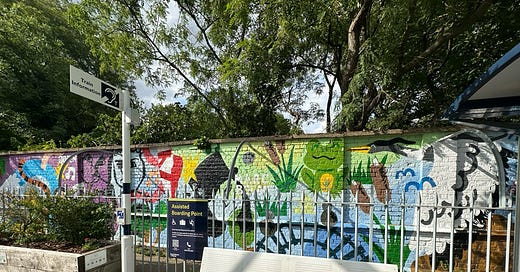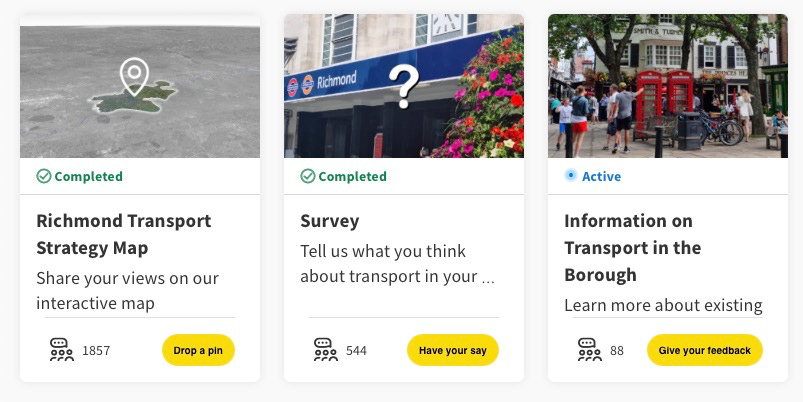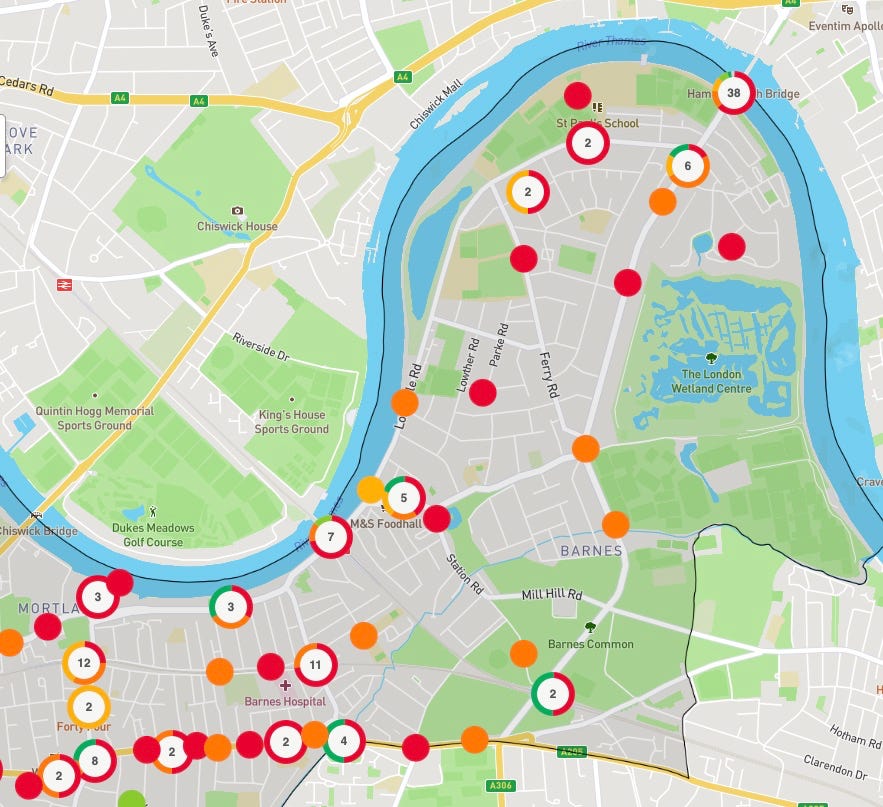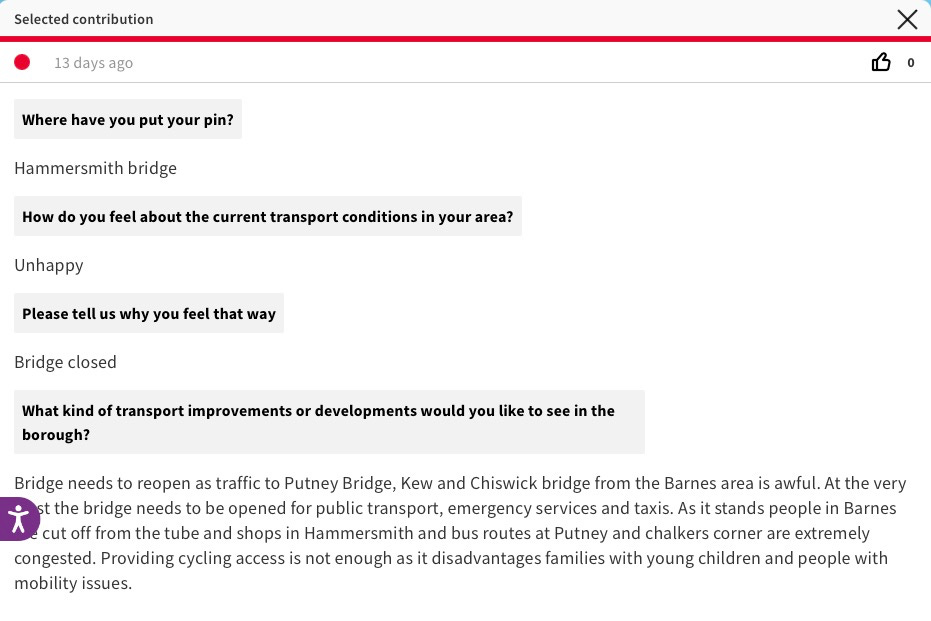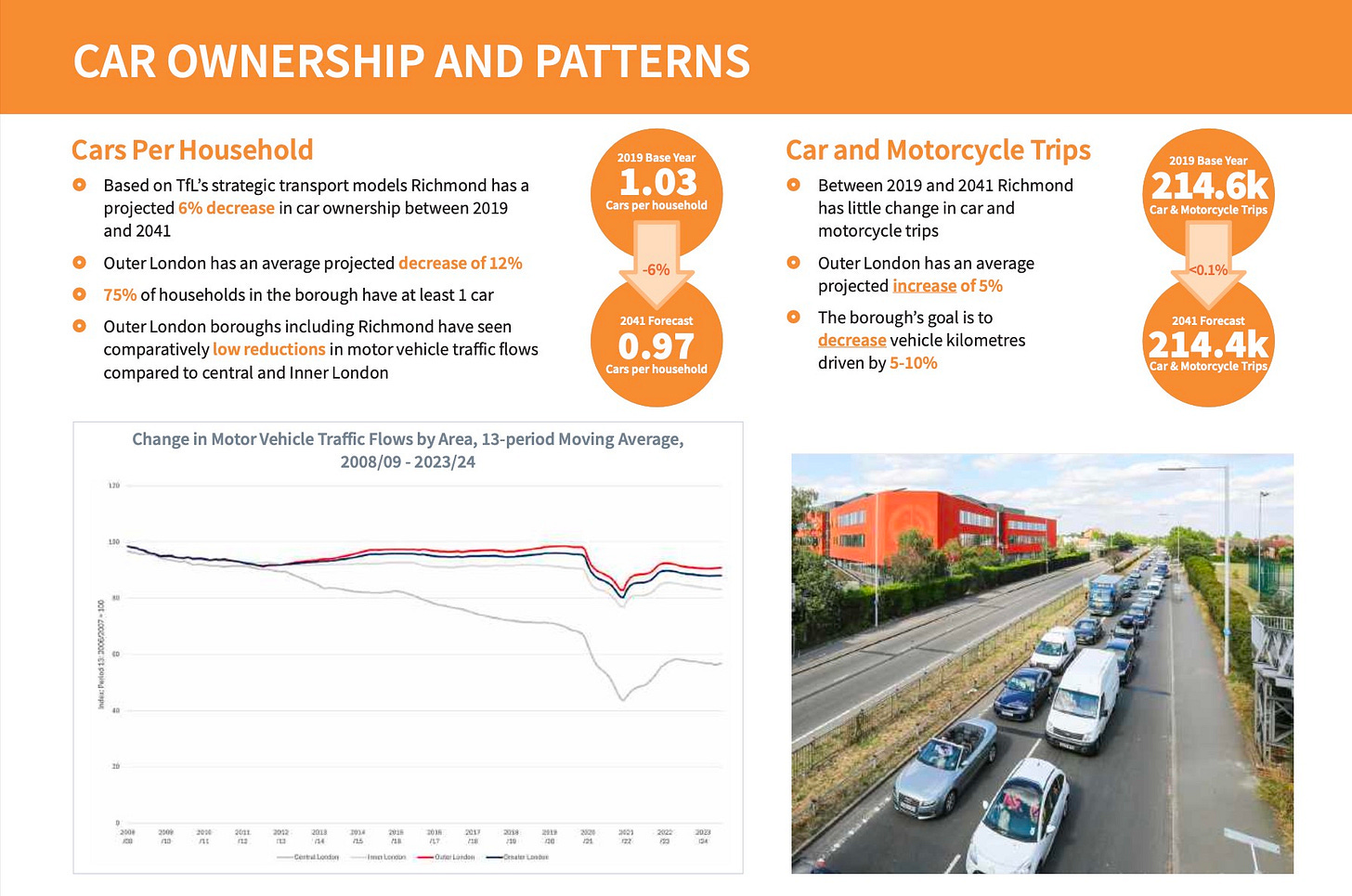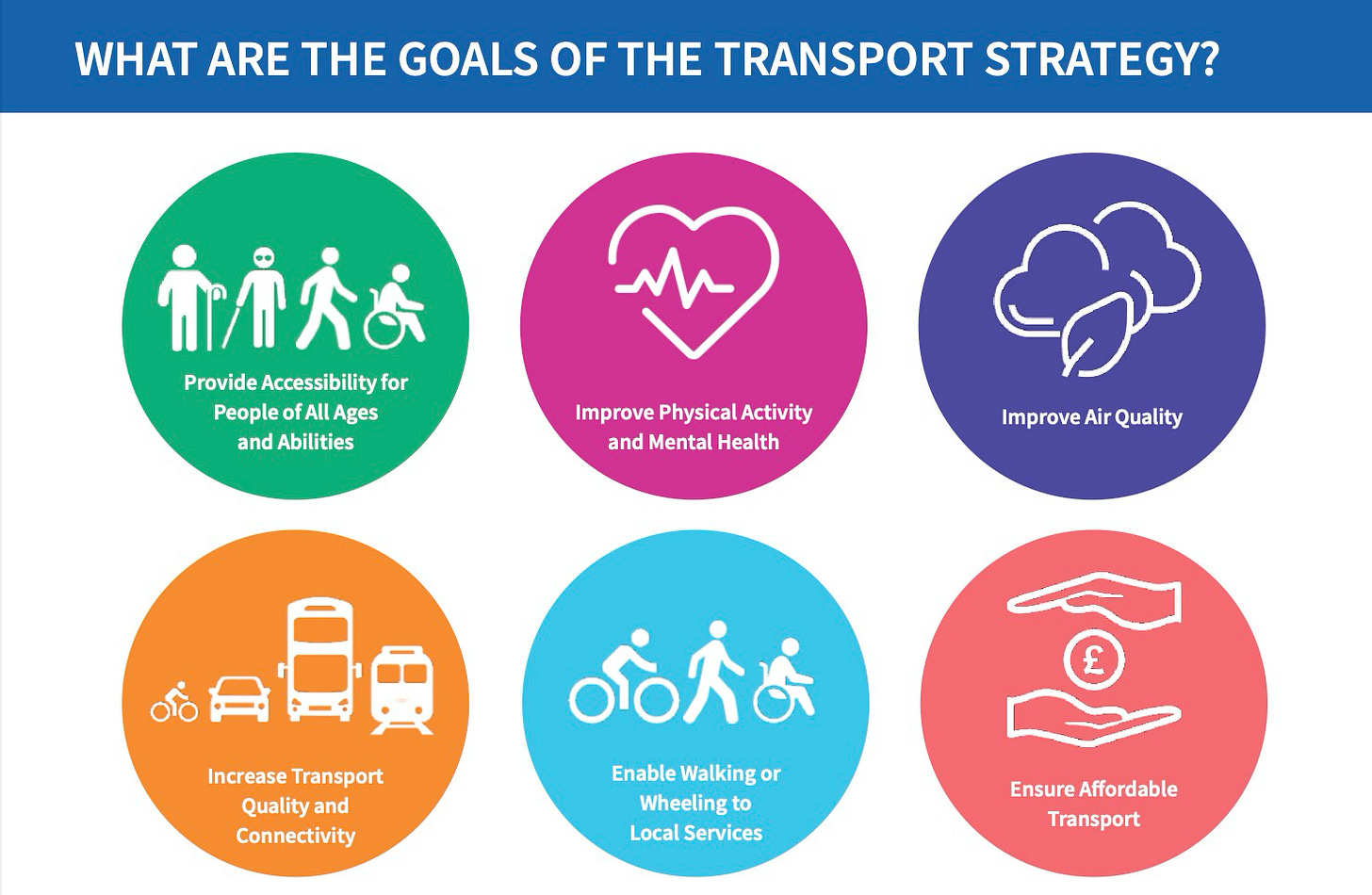Richmond council wanted our thoughts on its next Transport Strategy - here you go
Notes & thoughts on the next fifteen years - Story 76
Richmond council is asking for residents’ views on a new transport strategy that will shape life in the borough for the next fifteen years.
In theory, this is a moment to welcome. In practice, I approach these consultations with caution. I’ve helped run exercises like this before, and I know what a good one needs.
At minimum, there are three ingredients:
The insight of elected leaders
The considered views of the public
Credible polling to balance out the biases of the self-selecting
Too often, that third part is missing.
Those who speak up aren’t always representative of the many who don’t. And there’s good evidence to suggest many residents underestimate how widely their own views are shared — a classic case of pluralistic ignorance. This discourages meaningful engagement. I am not aware of any Richmond council polling activity like this.
Then there’s the timing. This process came early for me. My own ideas as this blog shows, are still taking shape. What follows, then, is a set of early thoughts — provisional, partial, best endeavours.
I will explain the process of submitting opinions then summarise my comments.
A User’s Guide to the Consultation
Richmond Council invited you to make two contributions.
For the first you drop a pin on the map and provide a comment. You can read what others have said, too.
Here is an unhappy driver. His/her identity is protected by the Council.
The second input - a survey - is no longer open. But you can read what people have said. Reading this list is not for the faint hearted - the entries are loaded, one after another. An initial analysis of these submissions was shared at the May Richmond council Transport Forum with a promise of making it available.
The third element on the page is a useful summary of borough including transport. Here is the page about car ownership.
My submission
This an edited version of my annotated pins on the map and my survey answers.
Things I liked
This was a long including the following:
The new Hammersmith Bridge prioritising pedestrians and cyclists
The new mural at Barnes Railway Station. Transport terminals are all too often grim. Not in this case
The new wider pavements on Barnes High Street
The new minimalist-style seating near bus stops on Barnes High Street. I cycle and walk past these a lot. I see then used a lot. More than I was expecting.
Improved paths along Thames from The Ship until Barnes High Street
20mph speed limit throughout the borough
Wider availability of shared bikes (Lime etc) which are so important to young Londoners
Reliability of SWR train mobile app
Increased provision of bike stands throughout Barnes and Mortlake
My new Oyster Photo card. An awesome birthday gift.
Things I don’t like
In no particular order.
Pedestrian crossing at Essex House - we must be able to do better than a council-sponsored game of chicken. On the one side a thriving high street - kudos for the council’s part in reviving it - and on the other an attractive social centre of the area. Between a busy road where drivers in both directions happily rapidly accelerate. With no crossings to funnel pedestrians, they march across at the highway multiple points. Why do you think this is acceptable? Serious question. I am interested in the principles and how they are applied elsewhere.
Paint is not protection - I am a regularly cyclist on the A305. That painted bike lane flatters to deceive. Sometimes the cars are going to fast and sometimes too fast and too close. I do not feel protected
The Terrace - arguably worst stretch of bike-riding road in Barnes and Mortlake, currently. Close passes are the norm. Cars overtake at speed then cut in because of the surprise of on-coming traffic. Some are abusive: Spring in Barnes on The Terrace with a bike is an open invitation from sports cars with soft-tops down to shout abuse. After consideration, I decided to continue using this road even if it means riding down the middle of the lane to a symphony of car horns
Nowhere to park my bike safely at home - there’s no back access to my home. I am deeply reluctant to leave my bike in the front garden. Could we have a bike hanger?
White Hart Lane rail crossing - why not contain the frustrations of (mainly) drivers by providing a countdown of when the next train is due? This is normal for buses and trains in the borough. Transport and time are fundamental for apps like City Mapper and services like Uber. And who would fly without such an expecation. Fills a void, who after sitting idling, express their frustration by doing something daft or aggressively pull away the moment the barrier rises
Suggestions for shaping the strategy
The next points are broader or thematic. They are ideas for shaping the overall strategy. Again, in no particular order.
Walking, focus on walking
This summary chart can be improved.
The heart of the new strategy should be walking.
The most important measure of success in Richmond’s transport is shifting the current mode share from 61% to 75% by 2040 for trips to be taken by walking, cycling, and public transport. Do that and air quality, health improvements follow.
The behaviour change required to deliver that is increase the amount we walk. More people will switch from cars to walking than cars to cycling. I write this as a keen cyclist. At the height of lockdown less than 5% of trips were made by bike across London, including the inner boroughs.
The council needs to take a systemic approach to encouraging residents to make fewer car trips. Walking needs to be easier. It needs to be made safer. More of our streets should feel less like roads. Fewer pavements should be blocked by large cars making them unpassable.
There should be more simpler side road zebra crossing. Where there are full zebra crossings, their timings along roads should be adjusted to prioritise people not vehicles. Wait time at zebras should be lengthened. There should be zero tolerance for cars speeding through 20mph roads or parking illegally.
Richmond council should look at our built environment and manage the space fairly. Pedestrians and car drivers should treated as equals. A car has a comfortable seat, managed air, a cup holder and a sound system. Richmond council has no influence over car cabin design. It can influence how our roads, streets and public places. What is the equivalent offer from Richmond council for someone walking?
The car-first lobby will be appalled by this. As they did to the introduction of 20mph. Richmond council leader Gareth Roberts claimed his flowers - rightly - for taking a strong position on that change. He should do so again with this approach.
More disincentives for drivers
The council has two new transport related strategies. The Climate and Nature Strategy is more mature: it has produced a set of proposals. The travel and air-related proposals rely almost entirely on incentives to encourage people to move from private cars in particular to sustainable transport. If this approach is adopted din the transport strategy that will not be sufficient. Richmond council needs more disincentives.
Example - progressive car parking charges
Charge for parking by weight and/or size
Introduce gradually with plan to peak in say 5 years by which time differential should be material
Example - reduction in car park spaces
Reduce number of spaces by 1% every other year between now and 2043
Reduction should be targeted, relative to nearby accomodation type
Replace car spaces with either
SUDs
or bike hangers
Hammersmith Bridge plans
There are several strands to this.
Make clear the circumstances which would trigger Richmond council to implementing changes across Barnes and Mortlake because cars are not to be restored to the Bridge. The area is stuck in ‘environmental aspic’ - the road space use, the traffic lights, the bus routes only make sense with 20,000 cars re-routed north through Castelnau. There is a better way of managing our built environment. What would prompt Richmond to start that work?
Were it to become clear private cars will not be restored to Hammersmith Bridge, when will you and your Hammersmith & Fulham council partners revisit plans for very light vehicular access to the bridge, whether automated or not? These would enable those disadvantaged by the current arrangement - mainly elderly and/or disabled - to cross more easily. It would be a cheaper solution than building a taxi or bus-friendly bridge.
Related, please reveal your plans for any changes through Barnes and Mortlake assuming the Bridge remains for walkers and wheelers. You have had six years to prepare for this event. These should be deliverable in the early phase of the period covered by this strategy.
Be bold about an acceptable level of congestion
Congestion can be measured. Having read the council’s material and heard several councillors talk about this at public events, I am left thinking
it does not have a target level for congestion
and the council remains comfortable with a debate framed by car drivers who assume, sometimes saying, zero congestion is a possibility and anything more than that is unacceptable
The council should include an analysis of the borough using this approach? Then explain how over time the new strategy will help tend these areas to your new target congestion levels?
Also, in its Climate and Nature Strategy, the council included a useful calculation.
Local authorities are responsible for around 2% of emissions. However, the sphere of influence local authorities have is significant. As such, they can influence as much as a third of total emissions.
This talks to the total emissions: could the council include tthe calculation for just transport? And what makes up the balance? Again, this might help usefully frame the extent of Richmond council’s direct versus indirect influence during this debate.
One final point. here’s a single line buried in Richmond’s Climate Strategy that deserves more prominence:
By 2043 Richmond upon Thames’ roads will be noticeably quieter.
That’s not just a nice-to-have. It’s a test of seriousness. A quieter borough is cleaner, healthier, safer and fairer.
That’s the real opportunity in this consultation.
That is a worthwhile prize.

